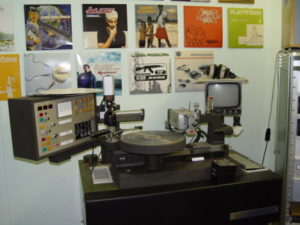
He also does live lathe record cutting performances with vintage lathes for parties.

He visits libraries and schools to give presentations on the history and science of sound records. Michael Dixon, 35, is a lathe cut record maker and owner of PIAPTK Records. Vinylium out of Switzerland offers the Kingston Dub Cutter at a similar price point and there’s a German guy named Souri who sells a machine called the Vinyl Recorder. There are actually already a couple similar products on the market, although they remain hidden deep within the lathe troll community so very few people own them. As much as he want to create vinyl mixtapes for his friends, or limited edition records for specific shows, he’s going to wait for a price drop. The one thing holding Heath back? The price and cost of materials to run the machine. No one is doing that because everyone wants something physical. “With something like this you could really have your finger on the pulse. It’s so easy to write and record a hardcore song with home recording, but it takes forever to get records pressed,” Heath said. “It would be so cool if a band released an actual record right after Ferguson. Scotty Heath, 36, owner of Tankcrimes Records, thinks that with label backing a band could use the DRC to keep up with the fast-moving digital world, creating social commentary while issue are still red-hot. “Even without this, we are working on making The DRC obtainable for the everyday user and have slated development of a consumer model.” “If we can get enough support, we can scale up production and bring the costs down substantially,” Tayar said. One key element to its success is the promise that all funds will be used to expand production and reduce the selling price, something that is restricting interested parties from buying the desktop lathe. The Kickstarter for the DRC has blown its goal out of the water, raising over three times as much as its stated goal of $10,000. The plastic records cut using the DRC will play longer than anyone could bear to listen, according to Tayar. The DRC uses a diamond cutting stylus to cut whatever music you want directly into a variety of materials, but is geared toward the use of plastic blanks.

It usually takes months, thousands of dollars, and requires a minimum order in the hundreds. The plant then uses the lacquer to create metal stampers, which actually make your records in the vinyl presses. The plant transfers that unlistenable garbage onto a soft, waxy thing called a lacquer (lacquers are actually toxic and flammable to the point of being explosive when cut, so they’re not exactly something you’d want on your desktop). The traditional way to get your band’s music on vinyl is to send it to a pressing plant.


 0 kommentar(er)
0 kommentar(er)
